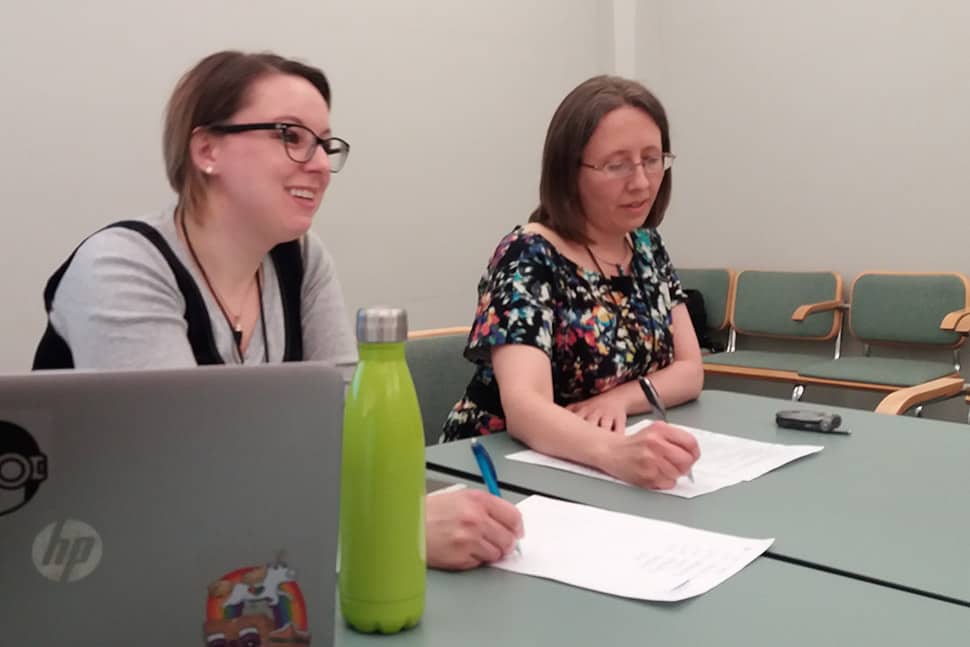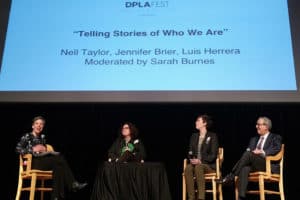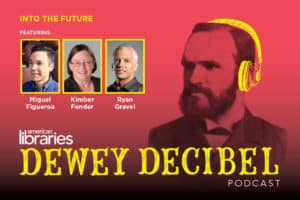
Data, storytelling, and design each have a role in spurring engagement, volunteerism, and social change. While much of the programming at Day Two of DPLAfest 2017, held April 21 at Harold Washington Library Center in Chicago, continued conversations about outreach, collection development, and issues central to the Digital Public Library of America (DPLA) community, speakers seemed to place special emphasis on the details we often overlook—clean metadata, user-friendliness, personal narrative, and face-to-face interactions that grow sparser in the online age. These seemingly small considerations are central to digital preservation and librarianship—and essential to nurturing content curators and users.
Data and design boost engagement
“A digital collection is not just scanned photographs,” said Greta Bahnemann, metadata librarian for the Minnesota Digital Library (MDL), at the outset of “Metadata: Preventing a Digital Junk Drawer.” Metadata should essentially make up half of your collection, she said.
Why is metadata so important? Bahnemann and copresenters from the Digital Arizona Library (DAZL) explained how it identifies, describes, disambiguates, aids discovery, facilities searching, and enables browsing for users. Metadata inconsistencies not only make content undiscoverable, she says, “but prevents you from entering an aggregate project like DPLA.”
Carefully selecting a metadata schema—such as METS (Metadata Encoding and Transmission Standard), Getty, Library of Congress, Dublin Core, or MODS (Metadata Object Description Schema)—based on your collection’s needs and feedback from peers can better set your project up for success and avoid future cleanup projects.
It’s also important that your digital collection doesn’t become unwieldy, remains culturally significant, and demonstrates research value. One common obstacle is “mission creep,” says Ryan Ehrfurth, digital coordinator at DAZL, which is when you repeatedly expand a project beyond its goals and end up with “hybrid collections” that don’t seem cohesive. For that reason, Ehrfurth thinks it’s better to say no to partners upfront regarding ambiguous items than to remove something from your digital collection later.
DAZL and MPL recommend having a gatekeeper who sticks to a strict collection development policy. “Metadata guidelines are both a teaching and enforcement tool,” Bahnemann and Ehrfurth iterated.
Data, along with design, is also important when it comes to media such as maps and atlases. In “Rediscovering Old Maps Through Engagement,” Evan Thornberry, reference and geospatial librarian at Boston Public Library’s (BPL) Norman B. Leventhal Map Center, discussed how these inextricable components came to inform his center’s new digital collections site, set to launch later this spring.
Leventhal Map Center (LMC), which handles the digitization and collection management of BPL’s 200,000 maps and 5,000 atlases (and adds to its collection “200 or so more maps every month,” according to Thornberry) primarily features historic items from 1482 to present. “We provide stewardship through public exhibitions,” said Thornberry. “We have a focus on creative educational use, particularly for K–12 educators.”
A digital collection is not just scanned photographs.—Greta Bahnemann, metadata librarian at the Minnesota Digital Library
To improve ease of use, LMC set out to create a new platform that emphasized engagement and revamped searching and browsing. The new digital collections site was awarded funding from two grants—one a National Endowment for the Humanities grant for repository extension, and another from the Institute of Museum and Library Services for educator tools. Developments focused on aspects such as visual design, spatial discovery, user-created data, and user-georeferencing, and were deployed with software including Fedora Commons, Hydra Project, GeoBlacklight, and Apache Solr.
LMC determined that there are seven typical personas who use its collection—such as the family history researcher, high school teacher, and the retired map collector—and the data needs of these demographic groups was what dictated changes to design and functionality.
“We’re trying to identify new users, especially in the digital humanities,” said Thornberry. “We want to cultivate our collections.”
Storytelling and face-to-face interactions make an impact
We can’t afford to lose storytelling in the digital age—whether it’s one-on-one interviews in the name of preserving our history, having tough community conversations to further social justice, or even those interactions between an organization and its volunteers.
In “Cutural Heritage and Social Change: Libraries Measuring Social Impact,” Jon Voss, strategic partnerships director at user-generated digital archive Historypin, kicked off the session by discussing the Knight News Challenge–winning “Our Story” project, a partnership between Historypin and DPLA that aims to bring people in communities together by getting them to talk to each other across generations. The storytelling project has been piloted in Louisiana, New Mexico, and North Carolina, and has brought together teen historians with Mexican-American veterans, the National Archives with the Russian River (Calif.) Historical Society, and other unlikely pairings.
Conversation has been a powerful tool in tribal communities, although outsiders “have to be okay with silences and spaces,” says Jennifer Himmelreich, Native American fellowship program specialist at the Peabody Essex Museum in Salem, Massachusetts. Himmelreich, who welcomed session attendees in Navajo and English, spoke to how technology is being used for cultural revitalization and preservation of tribal collections and archives—and what must be done to build knowledge communities and sustain connections.
As the Black Lives Matter movement grew, Jessica Anne Bratt, branch manager at Grand Rapids (Mich.) Public Library and a coordinator of Libraries 4 Black Lives, wanted community conversations to have more of a social impact. “We were all in this same rut where we do a booklist, and there may or may not be a conversation,” said Bratt. She felt it was time for “gritty” conversations that explored “what kind of advocacy we’d need to create change and dismantle oppressive systems.”
Bratt called on the community to meet and develop an actual outline for change. “It wasn’t perfect by any means—there were a lot of tears,” she said. But what resulted was a framework that superseded “boring advocacy,” as she puts it, and modeled a way to have these tough conversations in any community. Libraries 4 Black Lives will release a toolkit in June for other libraries wishing to guide discourse.
We were all in this same rut where we do a booklist, and there may or may not be a conversation.—Jessica Anne Bratt, branch manager at Grand Rapids (Mich.) Public Library and coordinator for Libraries 4 Black Lives
Sometimes we overlook the internal interactions that are essential to digital collections, such as maintaining good relationships with volunteers.
“Get your face out there,” said Kristina Eden, copyright review project manager for HathiTrust Digital Library, at the session “Harnessing Volunteer Power for Operational and Programmatic Success.” HathiTrust, a partnership of academic and research institutions offering millions of digitized titles, has depended on 165 remote volunteers—peers at member organizations—to do programmatic and operational work. Getting one’s face out there often means using applications like BlueJeans, Adobe Connect, Google Hangouts, and Skype to stay accessible.
“People won’t ask questions if they don’t feel comfortable,” said Eden.
Volunteers are served best with structured recruiting, onboarding, working, and offboarding. To run a robust volunteer network, training and documentation are key—as is connecting your volunteers to meaningful tasks.
“We must center our volunteers and their needs, skills, desires in the design of our programs,” said Angelina Zaytsev, collection services librarian for HathiTrust. “The work we do is valuable but should never be more important than our volunteers.”


